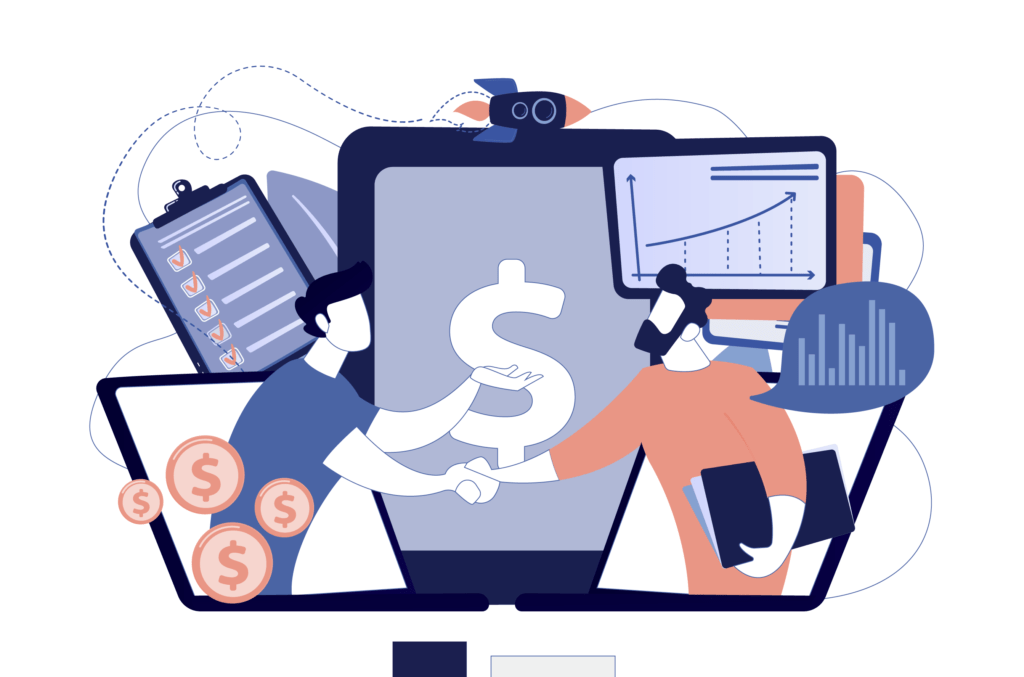Sales professionals use different styles of selling according to factors like whether they’re operating face to face or online, who their leads are, and the value of the sale. These styles fall into eight main types of sales — although there is some overlap.
1. Inside Sales
Sales over the phone, by email, through an online channel, or using another form of communication where the sales rep and customer never meet in person is called inside sales. These types of sales can convert both new and repeat customers.
Inside sales further divides into sales development and business development. Sales development reps find warm leads — for instance, users who have taken an action that indicates they may be interested in making a purchase. Business development reps, on the other hand, just work with cold leads.
2. Outside Sales
The opposite of inside sales in outside sales: reps meet with potential customers in person. Outside sales reps rarely work in the office or with a team. Instead, they travel to where their leads or customers are — either to close a deal or maintain a relationship with a current client.
Having said that, over the past few years, advancements in technology have changed the way outside sales reps work. Nowadays, the role does involve some remote contact with leads and customers. For instance, sales reps may use video conferencing when it is inconvenient to meet in person.
3. Transactional Sales
When most people think of sales, it’s transactional selling that comes to mind. This is likely because it is obvious the sales rep is trying to close a deal with transactional selling.
The process is simple: the sales rep uses prospecting to find opportunities, builds relationships with the leads, and then attempts to close deals. Usually, this only takes a short time, as the rep only attempts to secure a single sale from each customer. There is no anticipation of repeat business.
Since transactional selling is all about promoting products, the style is most appropriate for businesses trying to maximize sales in the short term. For transactional selling to be effective, customers should already know that they’re looking for a solution like yours. It is only suitable for standardized products, as there is no chance to upsell, cross-sell, or customize a product for an individual’s needs.
4. Solution Sales
With transactional sales, the focus is on the product. With solution sales, in contrast, the focus is on the customer. This sales style involves learning about an individual’s pain points and finding the right product or service accordingly.
Solution selling takes time to master. It’s important not to fall into the trap of putting your product first and thinking you are offering a solution. For example, if a sales rep starts expounding the benefits of a product in regard to the prospect’s needs, this is not solution selling. Instead, you need to center on what the purchase will do for the customer and how it will improve the customer’s life.
If leads require some nurturing before they’re ready to make a decision about what to purchase, solution selling can be appropriate. It’s ideal when you have prospects who are aware they have a problem but are unsure how to fix it.

5. Provocative Sales
In the case prospects are unaware they have a problem, you may like to use provocative selling over the other types of sales. This is all about shocking prospects to help them see they need to purchase your offering. The most experienced provocative salespeople are able to close deals in any financial climate, including recessions.
For provocative selling to be effective, you need to frame your product or service as the only viable solution. Therefore, this sales style only works for businesses who have created something unique and are targeting specific buyer personas who require these characteristics.
As an example, you can use provocative selling with clients who are currently investing in a traditional solution and demonstrate how your offerings are better. Your service could be less expensive, more modern, provide more comprehensive features, or even be lower risk. To succeed, it’s best to target innovators and early adopters.
6. Consultative Sales
Consultative selling involves having a conversation with prospects about their needs and posing the right questions at the right times to bring leads to the realization they need your solutions. Like with provocative sales, this style is for when leads are unaware that they have a problem. However, leads should also be unwilling to accept the severity of the problem and require your help to come to this realization.
Only skilled sales reps will see success with consultative selling. You need to be able to empathize with prospects, understand how exactly leads are feeling at each point in the customer lifecycle, and be able to build a sense of trust with your leads. You need to know what to say and, more importantly, know how to listen.
Unlike many other types of sales, this style is only worthwhile for high-value products and services. In addition, it needs mostly face-to-face interactions — meaning it is only suitable when outside sales are feasible. Consultative sales is especially popular with coaches, real estate professionals, and other types of one-person businesses.
7. Insight-Based Sales
Another style of sales that only a minority of reps have been able to master is insight-based selling. However, this style has become more important as prospects gain more choice and are able to research their options. Leads are no longer impressed when a salesperson simply presents the benefits of a business’s offerings.
At the same time, though, consumers often feel overwhelmed by choice and don’t know where to begin with research. Insight-based selling allows businesses to use this to their advantage by framing their own offerings as the right choice.
Insight-based selling requires a great deal of research. It’s about gaining a deep understanding of potential customers, including the challenges they face. You’ll need to dedicate a great deal of time to examining trends and other analytics in search of insights. It’s critical that the solution you want to propose actually is right for the individual. Plus, you’ll need to spend more time listening than speaking — insight-based sales is all about proper conversations rather than delivering sales pitches.
The large amount of effort that goes into insight-based selling means this option is only suitable for high-value sales. A lower-intensity option that uses similar concepts is solution sales.
8. Social Sales
Finally, there’s social selling. This is quite different from social media marketing: instead of waiting for prospects to come to you, it involves seeking users out and building relationships with them by joining in their conversations.
Rather than simply offering your services cold, you need to find prospects who are voicing concerns or in some way demonstrating they have a problem that your product or service could fix. This means monitoring for mentions of your brand as well as for terms related to your offerings and the issue you’re solving.
A social listening tool like Hootsuite Insights is ideal for monitoring social media platforms, whereas Google Alerts will send you notifications when anyone mentions one of the terms anywhere on the internet. Google Alerts is particularly useful for monitoring conversations on forums — if users are discussing your offerings or asking for advice, you can jump in and solve the problem. Better yet, everyone on the thread is a potential lead.
It’s worthwhile using a combination of both social listening and web alerts. Both are much more effective than searching for mentions yourself. Even though some mentions they reveal will be useless, others will generate qualified leads. The best social sales reps keep adjusting the terms they monitor based on which result in qualified leads. This helps them avoid wasting any time on leads who will never convert.
How to Use Virtual Assistants to Generate Sales
Figuring out the right sales style for your business and learning all the related best practices — on top of everything else you need to do for your job — is a challenge.
Contracting a virtual assistant for sales will take off some of the pressure. A virtual assistant will support you with everything from prospect research and lead generation to logging interactions and updating your CRM. Your VA will help you keep your pipeline full of leads at the same time as eliminating admin work from your schedule.
Receive a virtual sales assistant with experience assisting sales reps who use all the above types of sales by choosing MYVA360. Schedule a consultation and you’ll receive a special 10-percent discount on a VA for sales.





